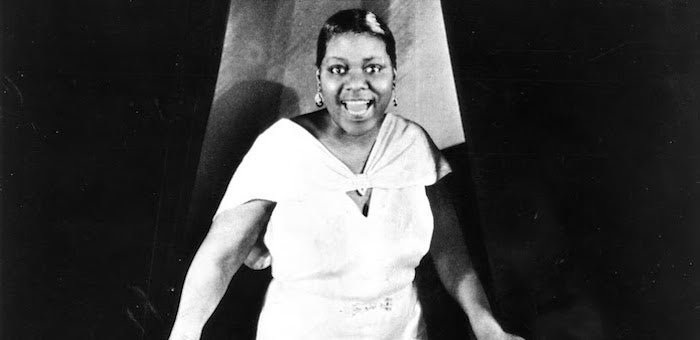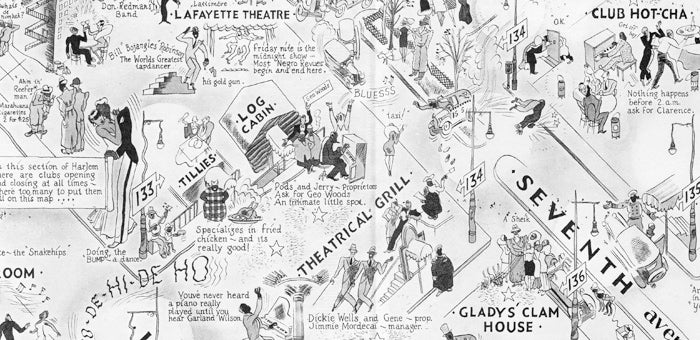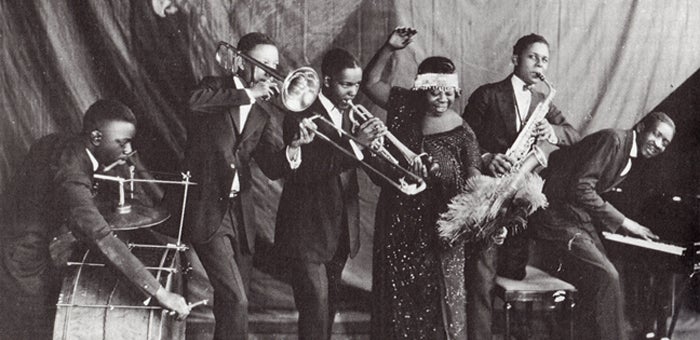You are here
Lesbian Chic in the '20s

Gladys Bentley
Introduction
Lillian Faderman is an internationally known scholar of lesbian history and literature, as well as ethnic history and literature. Her work has been translated into numerous languages, including German, Spanish, Italian, Japanese, Turkish, Czech, and Slovenian. Among her many honors are six Lambda Literary Awards, two American Library Association Awards, and several lifetime achievement awards for scholarship, including Yale University’s James Brudner Award, the Monette/Horwitz Award, the Publishing Triangle Award, the ONE National Gay and Lesbian Archives Culture Hero Award and the American Association of University Women’s Distinguished Senior Scholar Award. The New York Times names two of her book, Surpassing the Love of Men and Odd Girls and Twilight Lovers, on its “Notable Books of the Year” list.
This lecture was given June 3, 1990 as part of a Culture Series from 1989-1990, presented at the ONE National Gay & Lesbian Archives in Los Angeles.
This is a selection of excerpts from the lecture. Download a PDF of the complete transcript.
Lesbian Chic in the ’20s
[M]ore women accepted themselves as sexual creatures for the first time in modern history ... certain places emerged in the United States where lesbianism was more acceptable than it had been ever before.
Lillian Faderman: I think that the 1920s really saw something of the proliferation of the lesbian subculture throughout the United States. What I mean by that is not simply lesbians existing in friendship circles but rather lesbians trying to claim some public space for themselves, and it wasn’t yet very widespread but there were certainly pockets of this kind of thing as I’ve suggested. And I think it could happen in the 1920s for several reasons. I think that there was a huge break in the 1920s with what had preceded, and part of that break of course was due to World War I and the disintegration of old cultural values, the divorce from Victorianism that many people claimed. It was a time of experimentation in various areas, in art, in literature, in music, and I think also for many women in sexuality as well.
[...] And then in the ‘20s also there was the effect of feminism. More women were working at that time. That meant that they were able to support themselves, and they had some kind of vestiges of independence, and I think that through feminism, too, more women accepted themselves as sexual creatures for the first time in modern history. So, with all of this as a backdrop, then, certain places emerged in the United States where lesbianism was more acceptable than it had been ever before, and perhaps ever since, until the 1970s, the decades that followed that. What I mean by lesbianism, I should say, first of all, is not romantic friendships such as I talk about in parts of Surpassing the Love of Men (1981), but actually of sexual relations between women. And I found those to be fairly rampant in areas such as Harlem and Greenwich Village, and expatriate Paris particularly.

Bessie Smith
I think that Harlem was fairly open to black homosexuality, though not entirely without ambivalence. But I think it was also where many white people felt that they could go, to experiment with homosexuality, and to experiment with other things as well. They could visit marijuana parlors and what was called “sex circuses”, speakeasies replete with peepholes, and illegal gin, and things of that nature. Some of the clubs in Harlem were segregated clubs. Clubs such as the Cotton Club, for example, had all black entertainers and an all white audience, and presumably primarily a heterosexual audience. But then there were other clubs that were much more interesting. And they catered to both blacks and whites, and both heterosexuals and homosexuals.
I think, for adventurous white people, Harlem was not only a place to go slumming, but it was also an arena where they felt that they could act out their enchantment with the primal and the erotic. There was certainly a kind of racism about that, I think. We can see it in all sorts of areas. [...] Collier’s Magazine at that time, for example, said about Harlem that Harlem had become a synonym for naughtiness.

"Night-Club Map of Harlem" (1932) by E. Simms Campbell
But I think other things were going on too. I think many white people found Harlem sexually enabling because it gave them permission to express what they couldn’t express in other places. And I think, especially for white people, to acknowledge their homosexuality they went to Harlem because they felt there were clubs there that didn’t precisely cater to gay people, but would really welcome their presence, even if it was just as one more exotic drawing card to the tourists.
[...] Biographies of the period suggested a similar kind of picture, of particularly wealthy white people going to Harlem to see and taste life, particularly in Harlem gay bars and lesbian bars. The singer that I mentioned earlier, Libby Holman, and her lover, a woman by the name of Louisa DuPont Carpenter, who was heir to many of the DuPont millions, were said to have gone to Harlem almost nightly for a period of time wearing identical men’s suits and bowler hats. And they were joined there apparently by other women celebrities and high-livers, many of them who were bisexual but who came to Harlem to be lesbian, women such as Jeanne Eagels, who was the first Sadie Thompson in “Rain”, and Beatrice Lillie, the actress, Tallulah Bankhead whenever she was in America, Marilyn Miller, who was sort of the quintessential Ziegfeld girl, a woman by the name of Lucille LeSoeur, who became much more famous later on under the name of Joan Crawford, and many other women whom the public thought of as being heterosexual but who were in fact bisexual and went to Harlem to be bisexual.

Louisa Carpenter
Sometimes they went to a place called the Lafayette Theater, where Bessie Smith, who was a bisexual blues singer, would sing. Sometimes they went to sex circuses. There was a famous one on 140th Street that was run by a madam by the name of Helen Valentine, and often featured lesbian acts. Of course all of this was for some people, I think, a kind of racism, as I’ve suggested. It was as though they could behave in Harlem as though nothing really mattered, as though their skin color would serve as a sort of armor and make them impervious to the […] or insults. And I think for some of them, they felt that the greater vitality that they thought they saw in black people permitted them to reach into areas of their own psyches, to discover and act on desires that they might have suppressed elsewhere. But the songs that they heard in these Harlem nightclubs really didn’t do much to foster the love of lesbianism as the concept of lesbianism as a love that did not speak its name. The image in those blues songs wasn’t always totally positive but it was always very exciting and sort of funky and delicious. It was often very assertive. There’s one that was very famous at the time that has since been recorded by a lesbian feminist singer, I think it was Chris Williamson. It was originally recorded by Ma Rainey in 1928 and was called “Prove It on Me Blues.” It’s a fascinating song because the singer there sort of toys with her audience. She implies that she really is a lesbian, that she’s interested only in women. But she insists that until she’s caught in the act, no one can prove anything about her.

Ma Rainey
It’s really sort of a song of lesbian pride at the same time that it recognizes the social stigmatization of lesbians. Let me read the lyrics to you. I wish I could sing. It’s much better when sung. “They say I do it, Ain’t nobody caught me, Sure gotta prove it on me. Went out last night with a crowd of my friends. It must have been women ‘cause I don’t like no men. It’s true I wear a collar and a tie, like to watch while the women pass by. They say I do it, ain’t nobody caught me, you sure gotta prove it on me. Wear my clothes just like a fan. Talk to the girls just like any old man. ‘Cause they say I do it, ain’t nobody caught me, sure gotta prove it on me.” It was originally released by a race records company, a company called Paramount, and I found a very interesting advertisement for it in the Chicago Defender. It was sort of an illustrated advertisement. It was a picture of a plump black woman who looked very much like Ma Rainey. She was wearing a man’s hat and a tie, vest and jacket, but she was also wearing a skirt and high heels, and I understand from the few informants that I’ve been able to contact who were in Harlem in the 1920s, that that was the usual dress for butch lesbians. They weren’t able, didn’t feel free to wear pants, so they would wear drag from the waist up, and traditional women’s clothes from the waist down.
“They say I do it, Ain’t nobody caught me, Sure gotta prove it on me. Went out last night with a crowd of my friends. It must have been women ‘cause I don’t like no men. It’s true I wear a collar and a tie, like to watch while the women pass by...”
[...] But while the number of women who were committed to lesbianism was probably not very large in the 1920s, I think it’s clear that a lot of women did experiment with it, for a number of reasons. And I want to suggest some of those reasons now. I think that one reason that so many women felt free to experiment with lesbianism at that time is that they often regarded it as being not different from romantic friendship in the 19th century. It simply took on another dimension, a sexual dimension. But they wouldn’t have called it, even though it was sexual, they wouldn’t have called it lesbian. I think some women felt free to experiment with lesbianism because it was for them a kind of maybe a brief sloughing off of restrictions on women’s sexuality, and I think that they felt that those restrictions were representative of restrictions on women’s freedom in general, and so it was one more area in which they would challenge restriction.
I think that some women felt free to experiment with lesbianism in the 1920s because for them it was a kind of acting out of repressed impulses such as Freud and psychoanalysis, which was so popular at that time, seemed to give them permission to do. And I think that many women were really encouraged by the public fascination with lesbianism. It really stopped being “a love that dared not speak its name” and began to be, at least for a short period of time, a relationship that women who were adventurous could feel free to deal with.
To report problems, broken links, or comment on the website, please contact support
Copyright © 2025 UCLA Film & Television Archive. All Rights Reserved






 Mobile Navigation
Mobile Navigation

